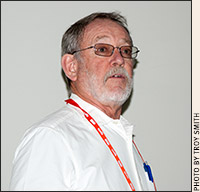Emerging Cattle Health Research & Issues Working Group
Vaccines for foothills abortion and FMD appear promising.
by Troy Smith, field editor, for Angus Media
SAN DIEGO, Calif. (Jan. 28, 2016) — Veterinary researchers say new vaccines hold promise for battling animal disease on two different fronts. Breakthroughs for immunization of cattle against foothills abortion and foot-and-mouth disease (FMD) were discussed during the 2016 Cattle Industry Convention Jan. 27-29 in San Diego, Calif. Researchers talked about advancements in producing both vaccines during a meeting of the National Cattlemen’s Beef Association (NCBA) Emergency Cattle Health and Issues Working Group.
 “Ticks don’t stay on an animal very long. They fill up with a blood meal and jump off, and they don’t feed very often, so parasite control has not been very effective,” explained Jeffrey Stott.
“Ticks don’t stay on an animal very long. They fill up with a blood meal and jump off, and they don’t feed very often, so parasite control has not been very effective,” explained Jeffrey Stott.Veterinarian Jeffrey Stott of the University of California-Davis College of Veterinary Medicine offered committee members a primer on Epizootic Bovine Abortion, more commonly referred to as foothills abortion. The disease is endemic in California’s coastal range and the foothill regions of California, Southern Oregon and Northern Nevada. Stott and fellow researchers have developed a vaccine that, so far, appears efficacious against the disease costing western ranchers, collectively, an estimated $3 million per year.
According to Stott, cattle become infected with the causative bacteria through the bite of the pajaroello tick found only in the intermountain West. Stott says the bacteria “sets up shop” in a pregnant female’s uterus, resulting in near-term abortions or weak calves. Up to 90% fetal mortality results from first exposure to ticks. Stott said preventing infection by trying to control ticks has not worked, since ticks are rapid and infrequent feeders.
“Ticks don’t stay on an animal very long. They fill up with a blood meal and jump off, and they don’t feed very often, so parasite control has not been very effective,” explained Stott.
Led by Stott, researchers at UC-Davis and the University of Nevada-Reno developed an experimental live bacteria-based vaccine. Preliminary testing of the vaccine began in 2011 and expanded testing is expected to continue into 2017.
 USDA-ARS veterinarian Luis Rodriguez talked about FMD vaccine research at the Plum Island, N.Y., facility.
USDA-ARS veterinarian Luis Rodriguez talked about FMD vaccine research at the Plum Island, N.Y., facility.“It has stopped abortions in commercial herds involved in the testing,” stated Stott, explaining that breeding females must be vaccinated at least 60 days prior to breeding; waiting 90 days is better yet. “We believe a single vaccination will be good for three years.”
Also reporting to the working group was USDA-Agricultural Research Service (ARS) veterinarian Luis Rodriguez, who talked about FMD vaccine research at the Plum Island, N.Y., facility. He reminded the audience that FMD is the major disease-related cause for disruption of world trade of animals and animal products.
Rodriguez said antigens are “banked” so that vaccine can be produced in the event of an outbreak. He admitted, however, that the current emergency-response system faces several challenges. There are many FMD serotypes. FMD vaccine typically has a short shelf-life. Immunity is of short duration, and persistent infection can occur among vaccinated and unvaccinated animals. Plus, the vaccine is very expensive to make.
“Certainly more ideal,” said Rodriguez, “is a vaccine that is safe, stable, inexpensive and quicker to make, offering broad coverage and long duration of immunity.”
Thanks to advancements in genetic engineering, scientists have tinkered with FMD virus DNA to produce a vaccine that poses no risk of inadvertently spreading the disease. The new product is stable and versatile, meaning it is adaptable to multiple serotypes of FMD. Plus, the vaccine can be produced more rapidly. Rodriguez said efficacy studies have shown that the relatively low-dose vaccine offers good protection against infection, including protection against persistent infection.
“More studies are needed, but this product looks very promising,” said Rodriguez.
Editor’s Note: The articles used within this site represent a mixture of copyrights. If you would like to reprint or repost an article, you must first request permission of the Angus Journal by contacting the editor at 816-383-5200; 3201 Frederick Ave., Saint Joseph, MO 64506. The Angus Journal claims copyright to this website as presented. We welcome educational venues and cattlemen to link to this site as a service to their audience.

